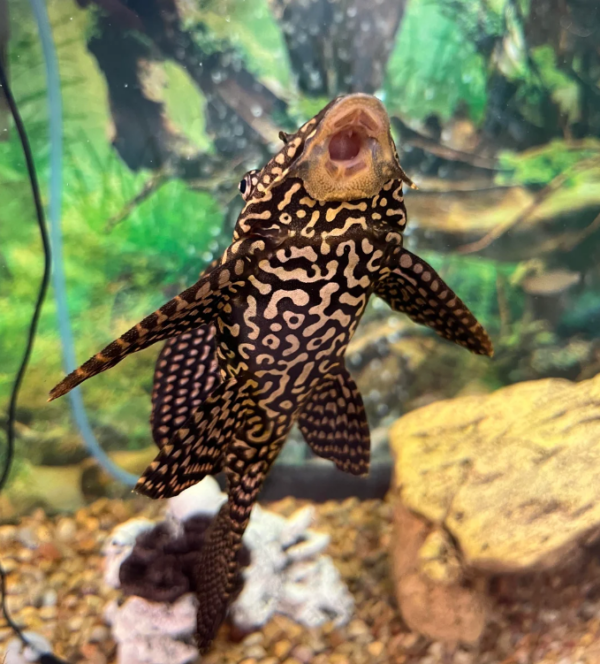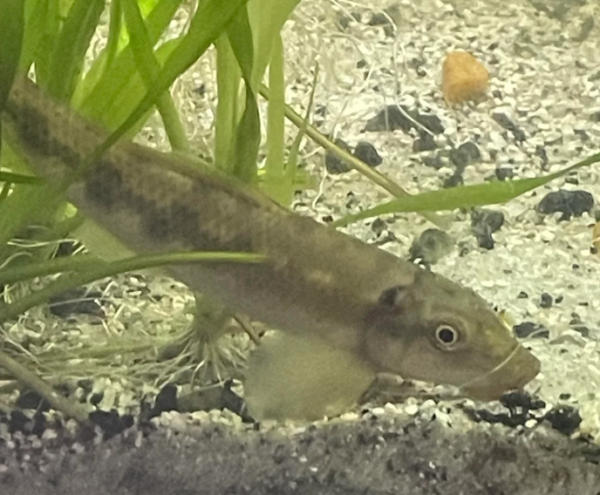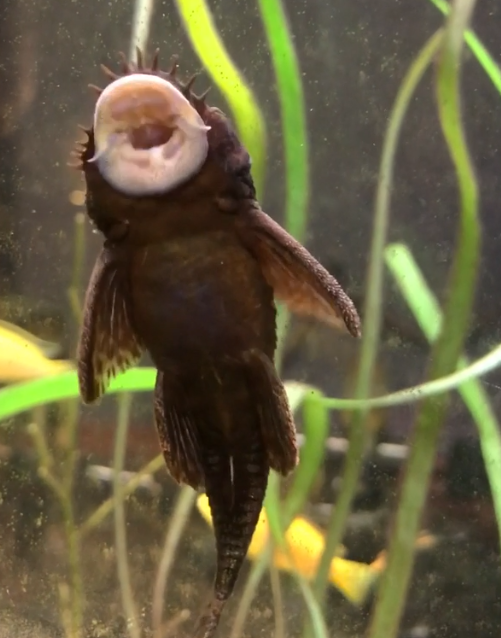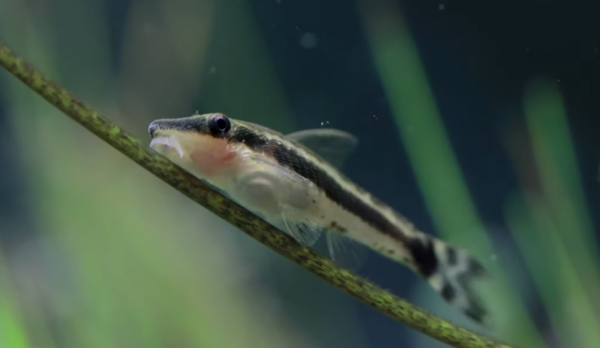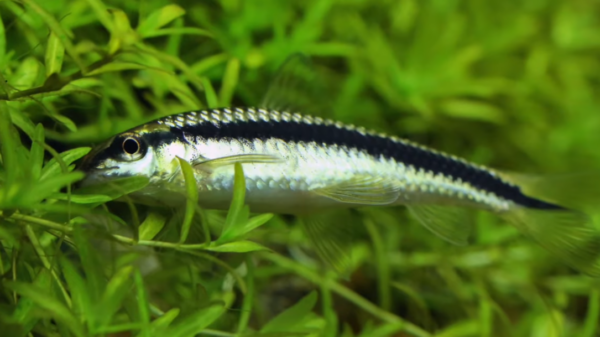Commonly known as the suckermouth catfish and common pleco, sucker fish are freshwater inhabitants belonging to the armored catfish family. They naturally occur in the Amazon River basin and its tributaries through the countries of Brazil, Guyana, and Trinidad and Tobago.
Sucker fish usually prefer relatively fast-flowing streams with fine gravel and sand substrates where they can sift through and find food. They inhabit environments with submerged branches, roots, rocks, and driftwood, where they can scrape algae off the surface and suck out small invertebrates and worms. Nutritionally, suckermouths are quite ineffectual but are in demand in the aquarium industry for bottom cleaning.
We reckon that you’ve already got a sucker fish or are deciding to get one. This article will help you get a good understanding of its care process.
Table of Contents
Sucker Fish Overview
Beginner aquarists often intertwine different species of plecos and refer to them as sucker fish. But, we’ll exclusively talk about the common pleco and its characteristics in this article. The nocturnal sucker fish are generally peaceful. They love to keep their activities to themselves unless threatened by the presence of another bottom-dweller. However, they prefer meaty food over algae and may hunt smaller fish and invertebrates in the tank.
Here are the key details of sucker fish to refer to when required:
| Information Chart | Sucker Fish |
| Scientific Name: | Hypostomus plecostomus |
| Family: | Loricariidae |
| Care Level: | Moderate |
| Temperament: | Generally peaceful but can get quite aggressive and territorial as they grow larger. |
| Color: | Brown or gray with darker spots or patterns. |
| Lifespan: | Average 10-15 years, but can live longer. |
| Size: | 12 to 24 inches, outgrowing most aquariums. |
| Diet: | Omnivorous. Feeds on both algae and meaty food. |
| Minimum Tank Size: | 75 gallons for a smaller Sucker Fish. More than 100 gallons for larger ones. |
| Temperature: | 72 to 78F (22 to 28C) |
| WaterConditions: | pH: Between 7 to 8 Moderate hardness |
| Tank Mate Compatibility | Other peaceful tank mates. Avoid other bottom-dwelling species. |
Sucker Fish Appearance
Sucker fish has a somewhat elongated and compressed body. Their bodies are covered in cycloid scales that offer protection against predatory attacks and external forces. Their head, however, is not as distinctly protected as their body.
Origin of the name sucker fish, their unique mouth is located on the underside of their head, equipped with sucker-like thick lips and bony plates to scrape algae off surfaces. Although sucker fish are known to be crawlers, they have fully developed dorsal, caudal, pectoral, and pelvic fins, helping preserve their natural agility and ability to gulp air from the surface.
Look-wise, common plecos are very polarizing. Some prefer their black and gray mundane looks, while most keep them solely to satisfy an aquarium balance requirement.
Types of Sucker Fish
Although we’ll still limit our discussion to common plecos, it would be criminal not to mention a few popular ones related to them:
- Bristlenose Pleco
Small size and peaceful temperament make Bristlenose plecos among the most popular species for aquariums. They have a bushy growth on their snouts, resembling bristles, hence earning their name.
- Zebra Pleco
One of the most stunning pleco varieties, zebra plecos are small and stunning with zebra-like stripes all over their body. They don’t grow over 5-6 inches in length and are pretty challenging to breed in indoor setups.
- Royal Pleco
Embroidered in majestic marbled body patterns and characteristically peaceful, the royal plecos can grow up to 18 inches long and rely on a herbivorous diet of algae and vegetables.
- Snowball Pleco
Aka the polka dot fish, snowball plecos showcase sparkling white spots on their black or brown body. These plecos are relatively small and are strictly herbivorous.
- Clown Pleco
Clownfish plecos have a distinctive brown and yellow striped pattern and are in the smaller size of 5 to 6 inches. Similar to common plecos, these also are omnivorous.
Lifespan of Sucker Fish
In the wild, sucker fish can live up to 20 years in their natural habitat. However, due to space constraints and increased stress in the environment, captive sucker fish live around 10 years in captivity. In a well-maintained aquarium with proper tank size, water quality, and nutrition, their lifespan can be increased up to 15 years.
Water quality, tank size, and nutrition are the key detrimental factor to a reduced sucker fish lifespan. A cramped environment, poor water quality, and an algae-only diet drastically disrupt their physiological functions and reduce their life expectancy.
Sucker Fish Size
Plecos never stop growing entirely. They albeit lose steam during adulthood, but they can grow incrementally throughout their lives and reach up to 24 inches in length, outgrowing most household tanks. It’s advisable to keep sucker fish or common plecos only if you have a tank to support their growth.
Whether due to lack of knowledge or ignorance, most beginner aquarists fail to acknowledge the growing potential of sucker fish. Kept in limited space and eventually released unethically in the wild, these sucker fish destroy the food chain and wreak havoc on local ecology.
Sucker Fish Care & Tank Set-Up
Sucker fish are relatively easy to care for and don’t necessarily need any exclusive routine to allow them to thrive. Let’s discuss the tank specification and water parameters for successful sucker fish keeping:
Sucker Fish Tank Size and Specification
As mentioned, sucker fish can grow to massive sizes. Owing to their potential size, you need to ensure that the tank can comfortably sustain its growth and massive bioload. Here are the key specs that you need to maintain.
Optimum Tank Size for Sucker Fish
Most sucker fish start around 2-3 inches in the trade. Very tiny. They don’t look like they can grow up to 24 inches in length, and most often, they don’t. Due to limitations in resources and tank size, their growth stuns around 15 inches. You may start small, but to unlock the full growth potential of your sucker fish, you must have at least a 150+ gallon tank to house the full-grown sucker fish.
Dimensions for a rectangular 150-gallon tank might look like this: 60 inches x 24 inches x 25 inches.
Tank Shape for Sucker Fish
Rectangular tanks are considered optimum for sucker fish as they grow longer and need to keep exploring the environment for food. Semi-circular tanks also work pretty fine for sucker fish. However, please avoid vertical cylindrical and circular tanks as they restrict the natural explorative nature of sucker fish.
Filter Type
Sucker fish are notorious poopers. They eat a lot and subsequently poop a lot. Therefore, running a powerful filter in the tank becomes necessary to reduce water change frequency and keep the beneficial bacteria colonies working. For small tanks with a small pleco, a sponge filter paired with a powerful HOB should be sufficient. Regular water changes are a must.
Canister filters with multiple filter media and floss are essential during the rapid growth stage of your pleco. It’s advisable to get a filter with at least 4x volume per hour over the tank volume. For example, if you have a 100-gallon aquarium, get a filter that can generate at least 400 GPH flow rate.
Nevertheless, if it’s a community tank, you need to adjust the flow rate accordingly.
Substrate
The ideal substrate choice for a common pleco is fine gravel or soft sand. In addition to producing biofilm that the pleco can scrape, fine gravel provides a smooth surface for your sucker to explore and find food scraps and organic matter buildup.
Soft sand, on the other hand, encourages pleco’s burrowing behavior and provides them comfort and a sense of safety.
Avoid large, sharp, or jagged rocks and gravel. They can trap food and damage the pleco’s sensitive lips when trying to burrow.
How Many Sucker Fish in 100 Gallon Tank?
While you can keep multiple smaller plecos in a 100-gallon tank, keep only a single sucker fish in the 100-gallon tank. A larger habitat, say, an outdoor pond, can keep multiple sucker fish together.
Water Parameters for Sucker Fish
While sucker fish adapt to most situations, they are pretty sensitive to water quality changes and parameter discrepancies. Here are the key water parameters that you need to maintain:
Water Temperature
Being cold-blooded creatures, most fish rely on the environmental temperature to adjust their metabolism. Sucker fish thrive on warmer waters of between 72 to 78°F or 22 to 28°C. Follow these tips to manage water temperature effectively:
To raise the temperature,
- Use a submersible water heater with thermostat adjustment. Ensure 3-5 watts per gallon of tank capacity.
- Position the heater against good water flow, ideally near the filter outflow.
- Reduce evaporation by using a well-fitted tank lid and reducing surface-level water flow.
- Increase ambient room temperature.
To reduce temperature,
- Bring your tank indoors and avoid direct sun during warm days.
- Increase evaporation by increasing surface agitation. Use a flow generator.
- Change water frequently. However, avoid rapid temperature drops.
Water Flow Rate
Most plecos, including sucker fish, prefer a moderate water flow. A good HOB or an adjustable canister filter should be able to provide sufficient current. Suckers also need a lot of oxygen and stimulation to perform their regular activities. If you’re seeing your sucker fish gulping oxygen from the surface frequently, it might be mitigated by increasing water flow.
Or, if the sucker fish is lethargic and hiding excessively, a reduced stimulation due to lack of sufficient water flow could be the reason. However, underlying diseases may also cause lethargy and shyness.
pH Level
Common plecos live in the slightly alkaline freshwaters of the Amazon River basin, where a pH of 7 to 8 is typically observed. You need to maintain a similar pH level in your tank to maintain your sucker fish’s physiological functions.
To raise pH,
- Use commercial pH buffers designed to raise pH in aquariums.
- Using crushed corals or limestone can naturally raise the water pH.
- Increasing aeration in the aquarium can raise the pH by outgassing carbon dioxide.
To reduce the pH in your aquarium,
- Partially change water with RO/DI water. Gradually reduce the pH
- Introduce driftwood that releases tannins into the water to reduce pH gradually.
- Peat moss in a filter mesh bag can be another tannin-releasing alternative.
Water Hardness
Owing to them living in a soft water environment with a very tiny hint of brackishness, sucker fish thrive in a water hardness of 4 to 17 dKH. They can even adapt to hardness levels in the 20s. Commercially available calcium and magnesium sulfate products can raise water hardness. Use them carefully. On the other hand, partial water changes with RO/DI water reduce water hardness.
Sucker Fish Tank Landscape
Several aquarists prefer to keep sucker fish in bare-bottom tanks, meaning without any substrates and minimal decorations. This can prove to be detrimental to the overall health and growth of your sucker fish. Here are the landscape components that you need to consider:
Best Plants for Sucker Fish Tanks
Sucker fish are particularly drawn towards tender and soft-leaved plants, sometimes to fulfill their appetite. Avoiding those, the best plants for your sucker tank may include:
- Anubias: Easily available. Easy to care for. Attaches to rocks and driftwood.
- Java Fern: Comes in a variety of shapes and sizes. Provides shelter to plecos. Attaches to driftwood.
- Water Sprite: Fast-growing. Allows plecos to nibble on the leaves without hampering the growth. Absorbs excess nutrients.
- Hornwort: Fast-growing. Appropriate for plecos to suck biofilm from. Provides hiding space.
- Amazon Sword: Classic aquarium plant. Tougher leaves. Comes in various sizes and colors.
- Water Wisteria: Fast-growing. Absorbs excess nutrients. Allows plecos to nibble on the leaves.
Worst Plants for Sucker Fish Tanks
Any plants that can’t withstand the sucker fish’s abuse are unsuitable for their tank. This may include:
- Water Lettuce
- Cabomba
- Dwarf Baby Tears
Furthermore, plants with a slow growth rate can’t keep up with the nibbling behavior of sucker fish. This includes:
- Cryptocoryne
- Red Tiger Lotus
It’s also best to avoid expensive or rare plants if you have plecos in your tank. Their grazing habits often damage or destroy sensitive plants.
Decorations for Sucker Fish Tanks
Hiding, grazing, and explorative spots are necessary for sucker fish to thrive. Here are some of the best decorations for your common pleco:
- Driftwood: A must-have for sucker fish. They hide in the crevices and caves formed by the driftwood pieces and scrape algae off the driftwood surfaces.
- PVC pipes: PVC pipes, cut into various lengths, create budget-friendly caves and tunnels for the sucker fish to explore and hide. Ensure that the edges are sanded smooth to avoid injuries to your pleco.
- Smooth rocks and stones: larger decorative stones and rocks provide additional surfaces to grow biofilm and allow the sucker fish to graze and ingest algae.
- Slate tiles: Slate tiles also provide additional smooth grazing surfaces to sucker fish.
Feeding Sucker Fish
Moving on to nutrition, here are the details that you would require to feed your sucker fish.
Best Diet for Sucker Fish
Plecos are often mistakenly thought of as algae cleaners only. Most beginner aquarists believe that an algae diet is enough for sucker fish, but they’re actually omnivorous and also need protein and fat for appropriate growth.
Your sucker fish will continuously graze on algae on rocks, decorations, and tank walls. However, a well-maintained aquarium may not have enough algae to compensate for their demand. Commercially available algae wafers are a good source of supplementary nutrition.
Blanched vegetables, meaning steamed for a short time, like zucchini, cucumber, spinach, and carrots, can be considered as occasional treats for your pleco.
If frozen proteins, such as shrimp and bloodworms, are unavailable, you may consider pellet food designed specifically for bottom feeders.
How often should you feed Sucker FIsh?
If your tank has a good amount of algae, let your sucker fish feed on its own through algae and organic matter. If required, supplement their diet occasionally every 1-2 days, depending on how hungry your pleco is.
Sucker Fish Tank Mates
The generally peaceful suckers are pretty suitable for larger community tanks. Here are the lists of ideal and bad tank mates that you can keep with your sucker fish:
Ideal Tank Mates for Sucker Fish
The ideal tank mates for sucker fish are:
Bad Tank Mates for Sucker Fish
The worst tank mates for sucker fish include:
- Large cichlids (Oscars, Flower Horns)
- Barbs (Tiger Barbs)
- Fin Nippers (Rainbow sharks, Gouramis)
- Other large Plecos
- Shrimp (Viewed as prey)
Sucker Fish Common Diseases and Treatment
Here are a few common sucker fish diseases that you need to keep an eye out for:
Ich
Small white spots appear on the body, fins, and gills of the pleco. They may also be flashing against objects or rubbing their body on decorations. Increase tank temperature slightly (a few degrees) and use commercially available Ich medication following the product instructions. Maintain good water quality during treatment.
Fin Rot
Frayed, discolored, or torn fins. The fins may appear clamped or shrunken. Maintain good water quality through frequent water changes and cleaning. Aquarium salt baths can be helpful in mild cases. In severe cases, medication specific to bacterial or fungal infections may be necessary.
Swim Bladder Disease
The pleco will have difficulty swimming and maintaining balance. They may float upside down or struggle to stay at a particular level in the tank. Fast the pleco for a few days and offer shelled peas as a laxative. Ensure good water quality and address any underlying causes like internal infections if necessary.
Facts About Sucker Fish
- Sucker fish have unique sucking disk mouth that helps them cling to rocks, driftwood, and aquarium walls.
- Sucker fish are actually omnivorous. While algae is an important part of their diet, it’s not the only part.
- Sucker fish are nocturnal creatures. They stay active during the night, searching for food and exploring their environment.
- Plecos have tough, bony plates covering their whole body.
- With proper care, sucker fish can live a long time, even over a decade.
- Sucker fish produce a lot of bioloads. Means they poop a lot.
- Sucker fish are found all over the globe.
Are Sucker Fish right for you?
Sucker fish is one of the most common fish that beginner aquarists get. But, they aren’t beginner-friendly and need massive tank capacity to grow optimally, which is often absent in the case of beginners. Sucker fish are right for you if you know how to maintain water quality in larger tanks and can accommodate their temperature, pH, and hardness requirements efficiently.
FAQs
A well-taken care-of sucker fish can grow up to 24 inches in captivity. However, the 15-18 inches max range is more typical in aquariums.
Sucker fish mostly eat algae and biofilm, but they also prefer meaty food like shrimp and small fish.
As long as their territory isn’t threatened or they’re not under stress, sucker fish don’t show any aggressive behavior.
Depending on the care level, sucker fish can live up to 15 years in captivity. In the wild, they live up to 20 or more years without any issues.
The Bottom Line
We’ve discussed the sucker fish care details in this article. Hopefully, you’ll now be able to properly attend to your sucker fish or common pleco without any issues. All the best!
No related posts.

